#fleckeri
Explore tagged Tumblr posts
Text
24 Gözüyle Yeni Bir Denizanası Türü
24 Gözüyle Yeni Bir Denizanası Türü Tamamen şeffaf bir gövde, uçlarında suda ilerlemeyi saglayan kürek benzeri yapılar olan 12 dokunaç ve 24 göze sahip bir denizanası türü keşfedildi. 24 Gözüyle Yeni Bir Denizanası Türü Gövde şekli nedeni ile kutu ve küp denizanaları olarak isimlendiren ve dünyanın en zehirli deniz hayvanı Avusturalya kutu denizanasını da (Chironex fleckeri) içeren gruba dahil…

View On WordPress
#24 Gözüyle Yeni Bir Denizanası Türü#Chironex#Chironex fleckeri#fleckeri#maipoensis#Tripedalia#Tripedalia maipoensis
1 note
·
View note
Text


Seven Pounds (2008, Gabriele Muccino)
26/08/2024
#Seven Pounds#2008#Gabriele Muccino#will smith#the pursuit of happyness#massachusetts institute of technology#Lung#liver transplantation#internal revenue service#Kidney#Bone marrow#Chironex fleckeri#Call centre#soundtrack#ennio morricone#giuseppe tornatore#The Legend of 1900#Green Car Motel#Loretta Mento#Muse#charles aznavour#Bird York#diana krall#ruth brown#carole king#Gerry Goffin#minnie riperton#Richard Rudolph#nick drake#que sera sera
8 notes
·
View notes
Text
Box Jellyfish Chirp!
youtube
I always make sure to mention this at every chance I get, but a box jellyfish put into an ideal position (so this one, basically- it's the only one I've seen actually make this noise) will chirp
// ok, "whistle" is probably the most correct term in this situation since I believe the sound is just air coming out of the jelly's velarium (what water typically passes through when the jelly swims underwater)

but the sound is close enough to a chirp that I just call it that. It's cuter that way, imo
62 notes
·
View notes
Text

Australian box jellyfish (Chironex fleckeri)
The Australian box jellyfish is found in the waters of northern Australia and Southeast Asia.
(Image credit: Brett Monroe Garner via Getty Images)
#brett monroe garner#photographer#getty images#australian box jellyfish#jellyfish#marine#chironex fleckeri#australia#southeast asia#nature
13 notes
·
View notes
Note
Why do you want to be stung by a jellyfish it hurts so bad 😭 it basically feels like you're getting burned and itches so bad
maybe I just want to who knows why
#It's like I'm getting kisses from a jellyfish let me have my fantasies pleaseeeeee#Ive seen case studies of bad Chironex fleckeri envenomations tho they're gruesome#Apparently the pain is so bad it can induce nausea and vomiting#Which pairs great with the hypertension (I think it causes hypertension? Could by hypotension tho I forget)#Also don't forget the scars#Mmm. Some leave sores that can break open and bleed more#...#Yeah not fun stuff#ask#mun rambles#Chironex fleckeri#Don't ask why I researched box jellyfish stings it was for a totally normal reason#This was also like 2 years ago so I completely forgot where I found to but whatever
12 notes
·
View notes
Text
Box jellyfish are so interesting to me.
#art talks about stuff#ik cubozoa's a whole class of beasts so this instance i'm talking about Chironex fleckeri#because that's the one i was taught to be scared of#but anyway they're so interesting to me#like i'm no stranger to dangerous animals but like. with stuff like crocodiles brown snakes red backs etc#i've actually seen them irl. i've never seen an alive box jellyfish with my own eyes#it's like some kind of spectre that's taunting me. almost beckoning me to go looking for it....#hopefully i'll see one one day. maybe at the aquarium while i'm in sydney
1 note
·
View note
Text
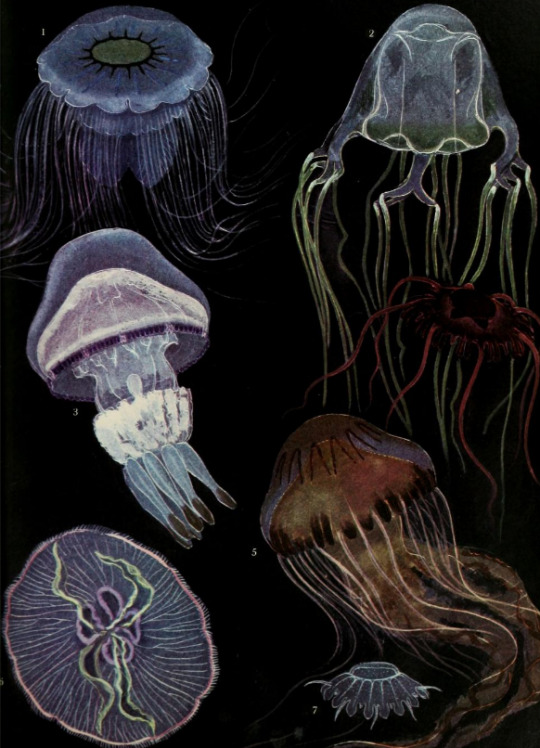
Grzimek's Animal Life Encyclopedia: vol. 1 - Lower Animals. Written by Dr. Bernhard Grzimek. 1974.
Internet Archive
1.) Blue jellyfish (Cyanea lamarckii)
2.) Australian box jelly (Chironex fleckeri)
3.) Barrel jellyfish (Rhizostoma pulmo)
4.) Nausithoe rubra
5.) Compass jellyfish (Chrysaora hysoscella)
6.) Moon jellyfish (Aurelia aurita)
7.) Crown jellyfish (Nausithoe punctatais)
#marine life#cnidarians#jellyfish#blue jellyfish#australian box jelly#barrel jellyfish#compass jellyfish#moon jellyfish#crown jellyfish
2K notes
·
View notes
Text
gonna preface this with i don't think vinegar is a cure for *every* jellyfish sting, but i don't actually know a lot about this. I'm going to use the box jellyfish as a case study, referencing this paper:
https://www.nature.com/articles/s41467-019-09681-1
box jellyfish venom is: "bioactive proteins that can cause potent haemolytic activity, cytotoxicity, membrane pore formation, inflammation, in vivo cardiovascular collapse and lethal effects in experimental animals"
so basically, proteins that fuck your shit up.
now vinegar is a weak acid (meaning it doesn't fully dissociate) with a pH of like...2-3ish. Based on my knowledge of proteins, many of them need highly specific environments to survive, so changing the pH can disrupt their function by causing them to denature.
please feel free to add more info/correct me, this is just a guess :3
hey scienceblr i have a really random question.
so you know how you’re supposed to soak a jellyfish sting in vinegar. what would happen if you soaked a jellyfish in vinegar? would it’s stinger just deactivate?
i’m actually like really curious but google will only tell me about stings so any actual help would be much appreciated :)
4 notes
·
View notes
Text
Character Ocs Ask List
Ramshackle:
- Darling Crowley
- Fiona Garten
- Junior (Twst Pluto from Black Butler/Kuroshitsuji)
- Yuu and siblings
Heartslabyul:
- Ciel Dalmetia
- Trix Jestor
Savanaclaw:
- Eric Stone (no Twst)
Octavinelle:
- Guppy Colossal
- Jacob Chiraboxe (Twst chironix fleckeri/blue box jellyfish)
Scarabia:
- Mona Sun (Twst Mozenrath/reincarnation of him)
- Cassim (Twst Cassim/Aladdin dad)
Pomefiore:
- Mirō Shards
- Adonis Flutter (Twst glass butterfly/Cinderella 20’s)
- Asmodeus Alice (Twst obey me/LISTEN THAT NPC NBC VICE PRESIDENT LOOKS LIKE HIM DONT SAY IT)
- Damian Dalmetia
Ignihyde:
- Alastor Gorgon (Twst medusa)
- Fayte Lyfie (Twst fate eye)
- Moro Engines (Twst Technopath from Sky High)
Diasonmia:
- Morgana Allister (dark horse/priest calling out Frollo)
- Hunter Scales (no twst, giant Junior who shapeshifts into dragons)
RSA:
- Horglas twins (separate or both)
- Ralpheus Garden
- Megumo (Twst Megara)
- Shaku (Twst Nala)
- Allunder Kingsley (Twst Alice Liddel (Tim Burton))
Co:
- Darling old friends (grown up or past selves)
- Haruto
- Aaron
- Joseph
- Elliot
- Grimsworth (also his wife/gf Primarose)
- Saber
- Malik
- Vicktor
- Aqila
- Imira
- Abbe
- Panny and Vanny
- Ryder
- Jamey
- Cypress
- and more because I have too fucking much apparently!
@adrianasunderworld @mangacupcake @writing-heiress @the-weirdos-mind @skboba-stars @nproduction626 @rose-tea-and-strawberries @anxious-twisted-vampire @yukii0nna @achy-boo @abyssthing198 @zexal-club @liviavanrouge
#twisted wonderland#twisted wonderland oc#twst#marron ocs#darling crowley#I’m not gonna list everyone#character ocs ask
14 notes
·
View notes
Text
(listen to this music while reading this blog)
Jellyfish: Nature's Ethereal Dancers
In the depths of the ocean, a delicate ballet unfolds. With translucent bodies aglow, jellyfish gracefully pirouette through the water, their movements captivating all who behold them. Drifting effortlessly with the currents, these gelatinous beings embody the beauty and mystery of the sea.
With their umbrella-shaped bells pulsating rhythmically, jellyfish come in a mesmerizing array of shapes and colors.
☆〜(ゝ。∂)

Places around the world where you can check out Jellyfish’s ballet production:
*・゜゚・*:.。..。.*:.。. .。.:*・゜゚・*
1. Jellyfish Lake,
Palau 🇵🇼
Jellyfish Lake in Palau is a renowned natural wonder where visitors can experience the surreal sensation of swimming alongside millions of golden jellyfish. Located on Eil Malk island, this marine lake is isolated from the ocean, creating a unique environment where jellyfish populations thrive without natural predators. Visitors can snorkel or dive in the crystal-clear waters of the lake, surrounded by gently pulsating jellyfish, creating an unforgettable and magical experience.
2. Kakaban Island, Indonesia 🇮🇩
A fascinating marine lake known for its unique ecosystem. Unlike Jellyfish Lake in Palau, Kakaban Lake is home to four species of non-stinging jellyfish, making it a popular spot for snorkeling and diving enthusiasts.
Visitors can swim among these harmless jellyfish and explore the underwater wonders of the lake, which also boasts vibrant coral reefs and diverse marine life. In addition to the lake, Kakaban Island offers pristine beaches, lush tropical forests, and excellent opportunities for snorkeling, diving, and relaxation in a
3. Miyajima Aquarium,
Japan 🇯🇵
At Miyajima Aquarium, visitors can marvel at mesmerizing displays of jellyfish, which are showcased in dedicated exhibits highlighting their ethereal beauty and unique biology. The aquarium boasts a diverse collection of jellyfish species, ranging from translucent moon jellies to vibrant sea nettles, creating a captivating underwater spectacle.
Through carefully designed displays and lighting effects, visitors can witness the graceful movements and intricate patterns of these gelatinous creatures, immersing themselves in the serene ambiance of the jellyfish exhibits.
4. Monteray Bay Aquarium, USA 🇺🇸
The Monterey Bay Aquarium is renowned for its mesmerizing jellyfish exhibits, showcasing a diverse array of species in stunning displays. Visitors can immerse themselves in the ethereal beauty of jellyfish as they gracefully drift through specially designed tanks, illuminated with captivating lighting to accentuate their delicate forms and vibrant colors.
One of the most notable jellyfish exhibits at the Monterey Bay Aquarium is the "Jellies: Living Art" exhibit, which features a mesmerizing collection of jellyfish species from around the world. Visitors can marvel at the translucent bodies and pulsating movements of moon jellies, lion's manes, sea nettles, and other fascinating species.
5. The Great Barrier Reef, Australia 🇦🇺
The Great Barrier Reef, located off the coast of Queensland, Australia, is home to a wide variety of jellyfish species. Among the most notable are the box jellyfish (Chironex fleckeri) and the Irukandji jellyfish (Carukia barnesi), both of which are known for their venomous stings.
While encounters with these venomous jellyfish are possible in the Great Barrier Reef, they are relatively rare, and most visitors to the region can safely enjoy snorkeling, diving, and other activities. However, it's essential for visitors to be aware of jellyfish safety protocols and to heed any warnings or advisories issued by local authorities.
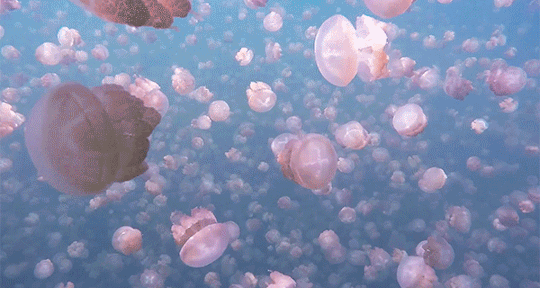



7 notes
·
View notes
Text
Hey Phans,
I have some big news to announce...
My new show "Keeping Up with the Cnidarians" will be swimming over to a screen near you very soon!
The show will follow me and the rest of my Cnidaria Phamily of hydrozoans, scyphozoans, anthozoans, and cubozoans. Join us to see all the exciting things we get up to. I'd like to introduce you to some of them right now!
From Class Hydrozoa, my cousin, Patty (Portuguese Man o' War)(Physalia physalis):
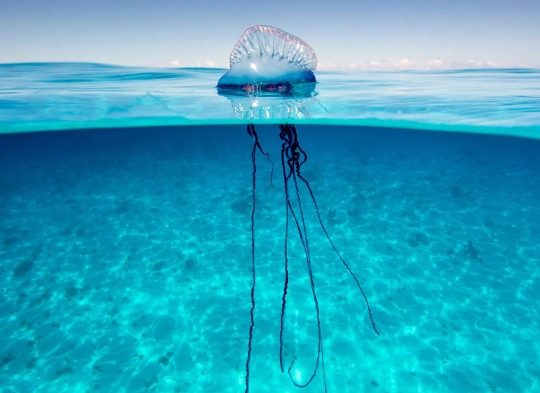
From Class Scyphozoa, my aunt, Molly (Moon Jelly) (Aurelia aurita):

From Class Anthozoa, my uncle, Otto (Orange Sea Pen) (Ptilosarcus gurneyi)
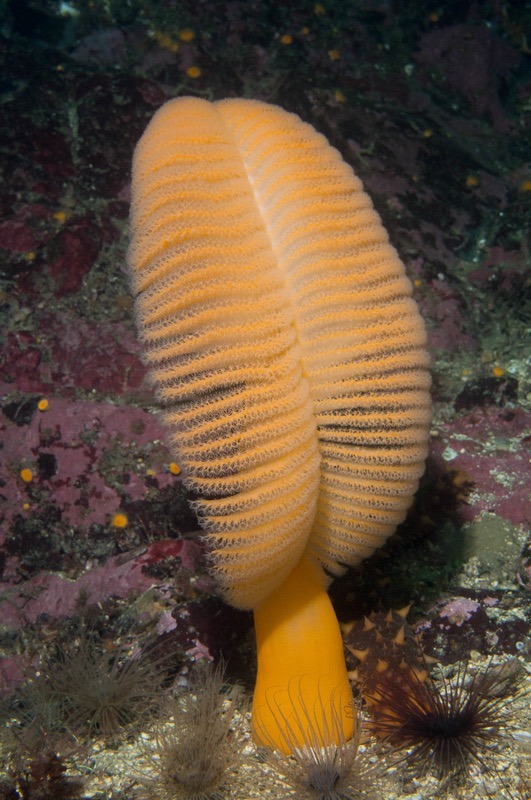
and finally, from Class Cubozoa, my favourite cousin, Chelsea, (Australian Box Jelly) (Chironex fleckeri)
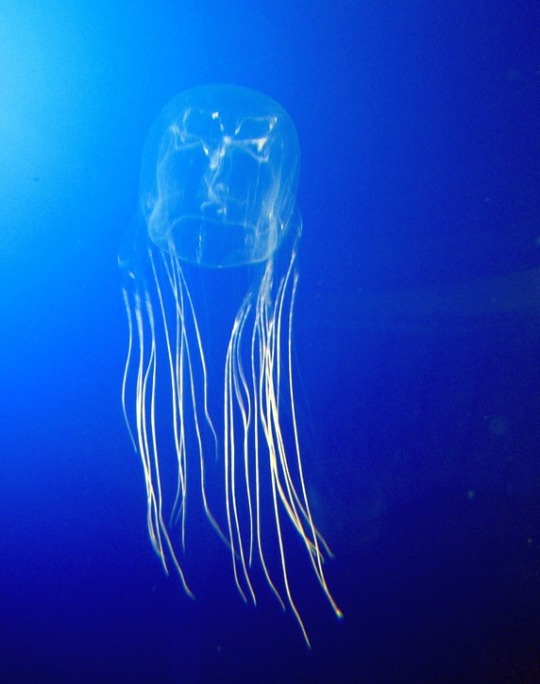
I hope you guys are excited about the show and don't hesitate to comment below who you're most excited to see undulating on your screens!
2 notes
·
View notes
Text
Newly discovered jellyfish is a 24-eyed weirdo related to the world's most venomous marine creature
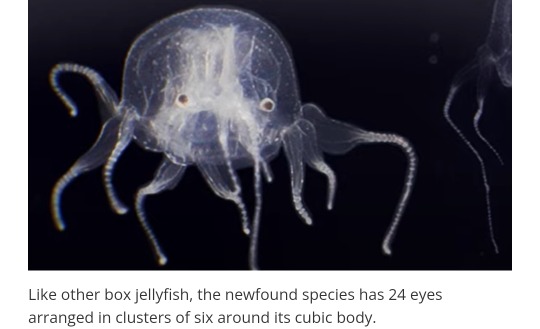
Researchers named the newfound species Tripedalia maipoensis, after Mai Po Nature Reserve in Hong Kong, where they discovered the transparent critter.
Scientists in Hong Kong have discovered tiny, cube-shaped box jellyfish in a brackish shrimp pond that are completely unknown to science.
The diminutive jellies have a completely transparent and colorless body, or bell, as well as 12 tentacles ending in small, paddle-like structures that enable the critters to speed through water faster than most other jellyfish species.
Like other box jellies — a group of Cnidarians that includes the Australian box jellyfish (Chironex fleckeri), the world’s most venomous marine animal, according to the National Ocean Service— the newly described jellies have 24 eyes arranged in clusters of six around its cubic bell.
"This box jellyfish connects the base of its tentacles and its bell with a flat base that looks like a boat paddle, making it distinct from other common jellyfish," Qiu Jianwen, a professor in the Department of Biology at Hong Kong Baptist University who led the research, said in a video. "Another feature of the box jellyfish is that it has six eyes located on each side of its body."
Researchers named the newfound species Tripedalia maipoensis after Mai Po Nature Reserve in Hong Kong, where they found it. They describe its features and relationship to other box jellies in a study published March 20 in the journal Zoological Studies.
T. maipoensis is the first-ever box jelly to be found in Chinese waters. It is unclear whether the half-inch-long (1.5 centimeters) animal can sting humans, but it may be venomous enough to stun tiny shrimp called Artemia. "It seemed to paralyze Artemia offered in the lab," Qiu told Live Science in an email. "But we did not touch the animal to feel the sting."
The researchers first noticed the unusual creatures in samples collected from an intertidal shrimp pond, known as a "gei wai" locally, during the summers of 2020 to 2022. The jellyfish were "quite abundant," Qiu told Live Science, numbering "up to 400 individuals in an area of the pond." A tidal channel from the brackish pool means that the species could also be present in the adjacent waters of the Pearl River estuary, but no work has been done yet to confirm this, the researchers wrote in the study.
Box jellyfish, which are also known as sea wasps, move by allowing water to enter canals that run along a muscular membrane on the underside of their bodies and then expelling it. The researchers found that, unlike closely related species, T. maipoensis has forked canals separating into multiple branches. The newly discovered species is the third known member of a group of box jellies characterized by tentacles ending in flat, paddle-like structures, called Tripedalia.
#Tripedalia maipoensis#2023#jellyfish#24 eyed weirdo#science#nature#cnidarians#tiny jellies#androgynousbirdtale
16 notes
·
View notes
Text

#teri yamaguchi#idk why autocorrect messed up his name on the last post lol#ocs#my art#i am so obsessed with halftones you don't understand#chironex yamaguchii#by the by- if I went with my usual hair colouring rules then I would've made his hair yellow#since most pictures of chironex yamaguchii show pale-ish to yellow tentacles#but I was kinda getting bored of light coloured hair so I decided to make it dark purple#I've seen chironex fleckeri with purple tentacles so I don't think it's too off model#His eyes are yellow to reflect the usual tentacle colouring though hihi
3 notes
·
View notes
Text
Avispa de mar: características, dónde vive, qué come y picadura

Bajo el nombre científico de Chironex fleckeri se esconde el que es considerado el animal más venenoso del planeta, la avispa de mar. Un único ejemplar de estas medusas contiene una cantidad de veneno suficiente para matar hasta 600 personas, de manera que, desde 1954, se estima que estas medusas han sido responsables de más de 5.500 muertes. Su potencial mortal se ha visto también reflejado en el cine, donde parece como causa de la muerte de algunos personajes en algunas películas.
Si alguna vez te has preguntado cuál es la medusa más peligrosa del mundo y te interesa saber más acerca de ello, desde EcologíaVerde te damos la respuesta a través de este articulo en el que te hablamos sobre la avispa de mar, sus características, dónde vive, qué come y su picadura.
También te puede interesar: Medusas del Mediterráneo
Características de la avispa de mar
Estas son las principales características de la medusa avispa de mar:
Es considerada una de las criaturas más venenosas y letales del planeta.
Otros nombres que se le otorgan incluyen medusa cofre, medusa de caja, cubomedusa o medusa cubozoa.
Estos nombres que vienen dados por el cuerpo en forma cuadrada que les caracteriza, desde donde se alargan los 60 tentáculos que presenta de unos 80 centímetros de longitud, pudiendo estos llegar a alcanzar hasta 3 metros de largo en fase adulta.
El tamaño de la avispa de mar oscila entre los 10 y 20 centímetros, sin contar los tentáculos, pudiendo alcanzar un tamaño similar a un balón de baloncesto, y se caracterizan también por tener un tono azul pálido, ser translúcidas y brillantes en la oscuridad.
Su vida es bastante reducida, con una esperanza de vida que va desde los tres meses hasta el medio año.
Como curiosidades de la avispa de mar y, diferencia destacada respecto otras medusas, es que presentan cuatro grupos de 20 ojos, mientras que la mayoría de las medusas son ciegas. Aun así, todavía se desconoce si ven como tal a través de ellos. Esta elevada cantidad de ojos, junto con los numerosos órganos sensoriales que tienen, compensarían su carencia de cerebro.

Dónde vive la avispa de mar
Tras conocer algunas de sus características más importantes, otra duda que nos asalta habitualmente es saber dónde se encuentra la avispa de mar, es decir, ¿dónde nos la podemos encontrar?
Las avispas de mar habitan principalmente aguas tropicales del Norte de Australia, generalmente desplazadas hacia la costa debido a las corrientes marinas. Aquí cohabitan con uno de sus seres cercanos, la irukandji (Carukia barnesi), una diminuta medusa del mismo orden que la avispa de mar y que es conocida por provocar el síndrome de irukandji, una enfermedad rara detectada por vez primera en 1922 que provoca fuertes dolores, taquicardia, náuseas, sudoración e hipertensión acabando con la muerte de la víctima.
La medusa de caja también habita por todo el océano Indico y Pacífico. No obstante, se han detectado ejemplares también en zonas de Nueva Guinea, Vietnam y Filipinas. Aunque la avispa de mar tiene una distribución geográfica amplia y pueden desplazarse grandes distancias, los adultos tienden a permanecer en áreas pequeñas restringidas. Aun así, todavía se está estudiando la presencia de esta medusa en otros lugares del océano.
Además, durante los meses de octubre y mayo, las avispas de mar se aproximan a las costas para reproducirse y, debido a este suceso, en numerosos lugares como, por ejemplo, Queensland en el noroeste de Australia, se prohíba el baño durante este periodo. Aquí puedes aprender un poco más acerca de Cómo se reproducen las medusas.
Qué come la avispa de mar
Como el resto de las medusas, las avispas de mar se alimentan de plancton y pequeños animales marinos. Por lo general, su alimentación se limita en aquello que llegue a ellas, ya que no cazan y por lo tanto no van a buscar alimento. En algunas ocasiones, además de comer plancton, algunos de los animales marinos pequeños que hemos mencionado que comen, también pueden ser medusas de menor tamaño, por lo que se convierten en depredadoras de otras especies de medusas. A través de sus tentáculos urticantes, estas medusas consiguen atrapar y matar a sus presas fácilmente.
En cuanto a los depredadores de al avispa de mar, la tortuga verde (Chelonia mydas) puede alimentarse de avispas de mar, ya que la gruesa piel que presenta evita que sean picadas de forma grave por esta peligrosa especie.
Veneno y picadura de la avispa de mar
A lo largo de sus tentáculos, las avispas de mar presentan millones de ganchos microscópicos (hasta cinco mil millones), llamados cnidocitos, llenos de veneno en su interior. Una sola picadura da lugar a necrosis de la piel y dolores extremos, y este veneno contiene una mezcla compleja de proteínas y toxinas que es miotóxica, hemolítica, dermonecrótica y letal, pues atacan al corazón, al sistema nervioso y al sistema respiratorio, además de a las propias células cutáneas y musculares de la zona que recibe la picadura.
En los seres humanos pueden provocar la muerte por paro cardíaco o parálisis por el dolor en cuestión de minutos. De hecho, el dolor que provoca el más mínimo roce con la medusa es tan intenso que puede provocar el shock en la víctima y, al estar en el agua, esta ahogarse, pues no suele dar tiempo a llegar a la orilla.
Con relación a otras medusas, se ha determinado que el dolor causado por el veneno de la avispa de mar es, como mínimo, 10 veces más potente que el de la carabela portuguesa (Physalia physalis) y, al menos, varios órdenes de magnitud más potente que el de la ortiga de mar (Chrysaora quinquecirrha). También se ha visto que, con el contacto muy leve con las avispas de mar y en el que la víctima ha logrado sobrevivir, este veneno causa importantes marcas con cicatrices en la piel similares a las que dejan un latigazo profundo.
Como dato interesante, a mediados del año pasado, investigadores de la Universidad de Sydney, en Australia, descubrieron un antídoto contra la picadura de las medusas avispas de mar, con el cual están en proceso de desarrollar una aplicación tópica para humanos.
Ahora que conoces bien a esta medusa, te animamos a conocer a otras con este otro artículo de EcologíaVerde acerca de los Cnidarios: características y ejemplos. Además, aquí puedes ver un vídeo sobre estas medusas.
1 note
·
View note
Text
41フォカロル・フレッケリ
40歳/186cm/海蜂水母の悪魔
¦
人間や対象を「溺れさせる力」を持つ。酒、タバコ、ギャンブル、薬物、権力、女(可愛い子なら性別を問わない様子)など、フォカロルが溺れさせることの出来るものは多岐に渡る。その力を持ってすれば、望んだ対象を極度の「中毒」や「依存」に陥れることなどは容易い。本人も酒や煙草、ギャンブル、かわいい子が好きな悪い男。煙草から出ている煙はカルキア・バルネシという名前の箱水母の悪魔。本人同様強い毒性があり、煙を浴びると数分で死に至る。ウェパルの叔父であり、ウェパルを可愛がっている。ふざけていて軽薄な態度を取る為誤解されやすいタイプだが、実力者。タツノオトシゴの双子の悪魔を保護している。ルカとラウムとカスピエルとは飲み友達で悪友。
基本プロンプト
👞、beautiful eyes,handsome male,ikemen,silver short hair,gray eyes,Chironex fleckeri,seawasp,enamel shoes、gold accessory, sunglasses, cigarettes, white fedora, beautiful decorations, handsome, dandy,flat chest、hair between eyes,white suit and black shirt,white pants


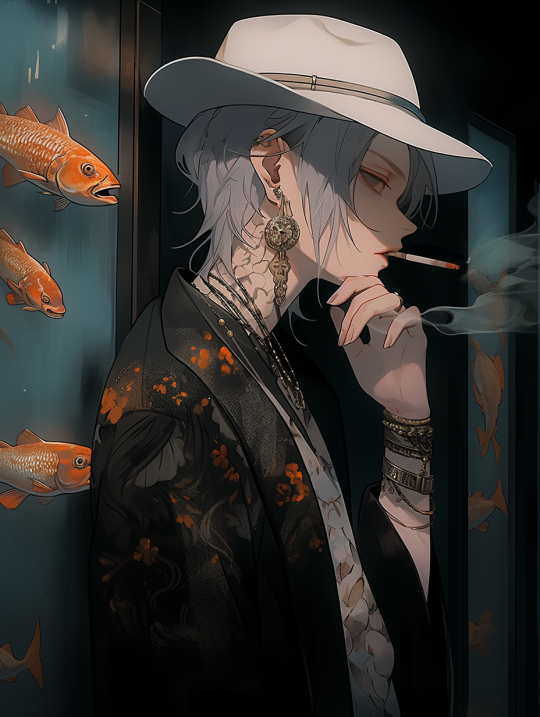
0 notes
Text
SPONGICOLIDAE
……. CHIRONEX FLECKERI
0 notes